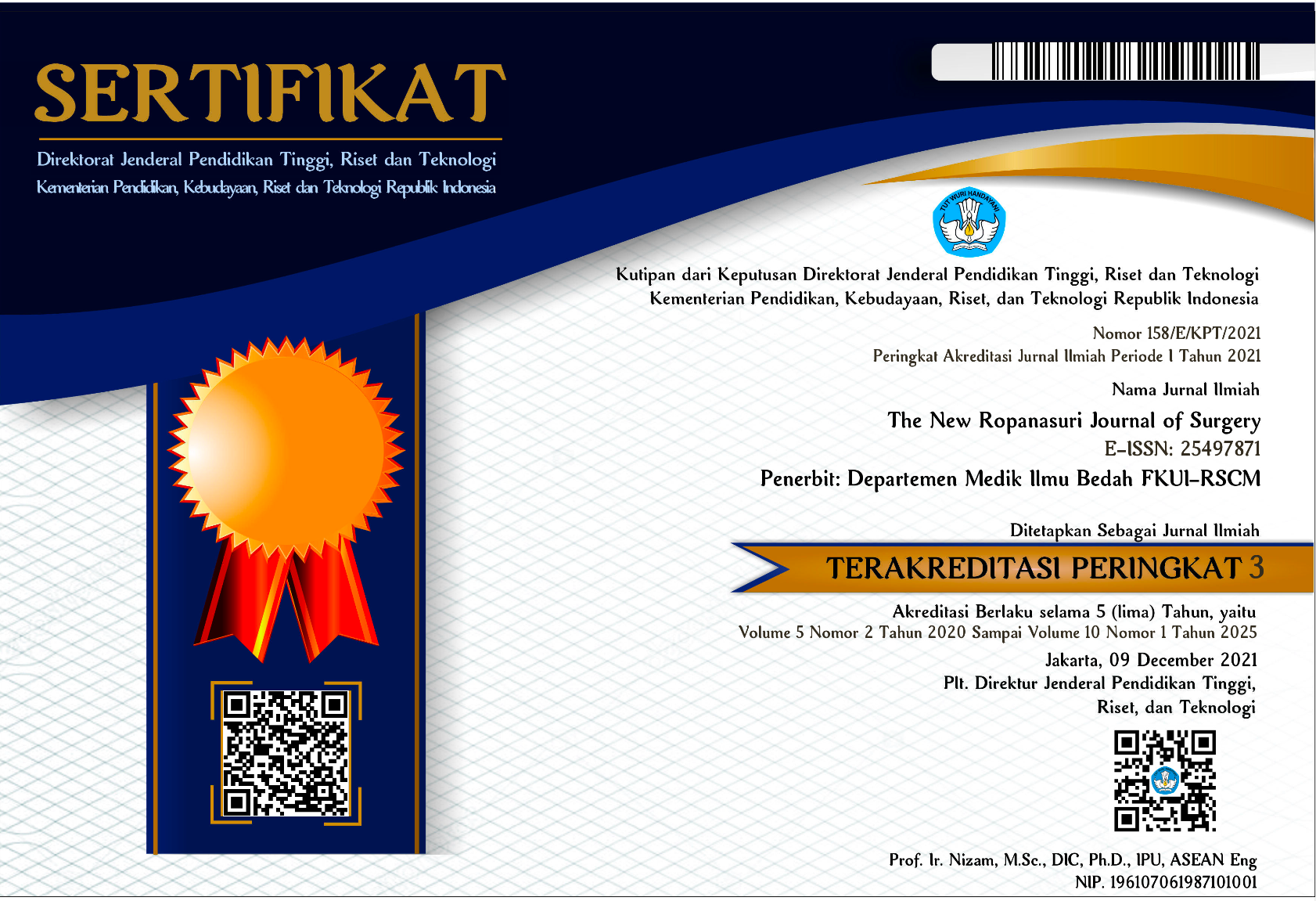Abstract
Introduction. It is estimated that around 15% of diabetic patients will experience diabetic foot ulcer (DFU) in their lifetime. Negative Pressure Wound Therapy (NPWT) is proven to be more effective than conventional treatments. NPWT creates a moist wound environment, increases local blood flow and stimulates tissue granulation thereby accelerating wound healing. This study was conducted to determine the risk factors that affect the length of stay of DFU with NPWT. Knowing this risk factors may be helpful for optimizing management strategy.
Method. This research was a retrospective study with a cross-sectional analytic design in 105 subjects treated in January 2016 to December 2018 at RS. dr. Cipto Mangunkusumo. Patient characteristics, demographics and risk factors were taken from medical records. The length of stay of the patient from the first application of NPWT to its outcomes was the main result, then the correlation to the risk factors that influence it was analyzed.
Results. The length of stay of DFU with NPWT was 19.9 ± 19.3 days. Risk factors affecting the length of stay were history of ulcers (r = 0.01; p = 0.034), wound depth (r = 0.292; p = 0.003), Hb (r = 0.05; p = 0.039), HbA1c (r = 0.06; p = 0.033), Albumin (r = 0.06; p = 0.017), PCT (r = 0.10; p = 0.035), and duration of DM (r = 0.193; p = 0.009).
Conclusion. This study showed that the length of stay of DFU with NPWT was influenced by systemic factors (duration of DM, Hb, HbA1c, albumin, and PCT) and local factors (history of previous ulcers and wound depth). The depth of the wound was the most positively related factor to the length of stay in DFU post NPWT (r = 0.292; p = 0.003). Interventions on factors that can be corrected before the application of NPWT may amplify the result of NPWT and reduce the length of treatment.
References
1. World Hearth Organization. Epidemiological situation. 2016; 5-6. Available from: https://www.who.int/leishmaniasis/burden/en/
2. IDF Atlas. Atlas of the Diabetic Foot Atlas of the Diabetic Foot 7th edition. Int Diab Fed. 2015;90-93.
3. Sitompul Y, Soebardi S, Abdullah M. Profil Pasien Kaki Diabetes yang Menjalani Reamputasi di Rumah Sakit Cipto Mangunkusumo Tahun 2008 -2012. J Peny Dalm Ind. 2015;2(1):9–14.
4. Huang C, Leavitt T, Bayer LR, Orgill DP. Effect of negative pressure wound therapy on wound healing. Curr Probl Surg. 2014; 301-11.
5. Hasan MY, Teo R, Nather A. Negative-pressure wound therapy for management of diabetic foot wounds: A review of the mechanism of action, clinical applications, and recent developments. Diabet Foot Ankle. 2015;6(3):4–13.
6. Fagerdahl A, Institutet K, Institutet K, Ulfvarson J, Institutet K, Ottosson C, et al. Risk factors for unsuccessful treatment results and complications with Negative Pressure Wound Therapy. Wounds. 2012;24(6):168-77.
7. Osterhoff G, Zwolak P, Kru C, Wilzeck V, Simmen H, Jukema GN. Risk factors for prolonged treatment and hospital readmission in 280 cases of negative-pressure wound therapy. J Plast Reconstr Aesthetic Surg. 2014;629-33.
8. Stannard JP, Atkins B, Cardiothoracic ST, Associates VS, Bernstein B. Use of Negative Pressure Therapy on Closed Surgical Incisions: A Case Series. 2009;55(8):58-66.
9. Ikura K, Shinjyo T, Kato Y, Uchigata Y. Efficacy of negative pressure wound therapy for the treatment of diabetic foot ulcer/gangrene. Diabetol Int. 2014;5(2):112–6.
10. Mouës CM, Vos MC, Van Den Bemd GJCM, Stijnen T, Hovius SER. Bacterial load in relation to vacuum-assisted closure wound therapy: A prospective randomized trial. Wound Repair Regen. 2004;12(1):11–7.
11. Armstrong DG, Boulton AJM, Bus SA. Diabetic Foot Ulcers and Their Recurrence. N Engl J Med. 2017; 2367-75.
12. Bakker K, Apelqvist J, Lipsky BA, Van Netten JJ, Schaper NC. The 2015 IWGDF guidance documents on prevention and management of foot problems in diabetes: Development of an evidence-based global consensus. Diabetes Metab Res Rev. 2016;32:2–6.
13. Mantovani AM, Fregonesi CEPT, Palma MR, Ribeiro FE, Fernandes RA, Christofaro DGD. Diabetes & Metabolic Syndrome : Clinical Research & Reviews Relationship between amputation and risk factors in individuals with diabetes mellitus : A study with Brazilian patients. Diabetes Metab Syndr Clin Res Rev. 2016;8–11. Available from: http://dx.doi.org/10.1016/j.dsx.2016.08.002
14. Shatnawi et al. Predictors of major lower limb amputation in type 2 diabetic patients referred for hospital care with diabetic foot syndrome. Dove medical press. 2018;313–9.
15. Roth-Albin I, Mai SHC, Ahmed Z, Cheng J, Choong K, Mayer P V. Outcomes Following Advanced Wound Care for Diabetic Foot Ulcers: A Canadian Study. Can J Diab. 2017; 41(1):26-32.
16. Loviana RR, Rudy A, Zulkarnain E. Artikel Penelitian Faktor Risiko Terjadinya Ulkus Diabetikum pada Pasien Diabetes Mellitus yang Dirawat Jalan dan Inap di RSUP Dr . M . J Kesehat Andalas. 2015;4(1):243–8.
17. Pusat Data dan Informasi Kementerian Kesehatan RI. 2018. Available from: http://www.depkes.go.id/resources/download/pusdatin/infodatin/hari-diabetes-sedunia-2018.pdf
18. Monteiro-Soares M, Ribas R, Pereira da Silva C, Bral T, Mota A, Pinheiro Torres S, et al. Diabetic foot ulcer development risk classifications’ validation: A multicentre prospective cohort study. Diabetes Res Clin Pract. 2017; 127:105-114.
19. Chuan F, Tang K, Jiang P, Zhou B, He X. Reliability and validity of the perfusion, extent, depth, infection and sensation (PEDIS) classification system and score in patients with diabetic foot ulcer. PLoS One. 2015; 10(4):124-9.
20. Martins-Mendes D, Monteiro-Soares M, Boyko EJ, Ribeiro M, Barata P, Lima J, et al. The independent contribution of diabetic foot ulcer on lower extremity amputation and mortality risk. J Diab Comp. 2014; 28(5):632-8.
21. Limawan, M. Hubungan Nilai Ankle Brachial Index (ABI) dengan Terjadinya Amputasi Minor dan Mayor pada Penderita Kaki Diabetik Di RSUPN dr Cipto Mangunkusumo. Tesis Program Pendidikn Spesialis 1, FK-UI Jakarta. 2016;27-30.
22. AlGoblan A, Alrasheedi I, Haider K, Basheir O. Prediction of diabetic foot ulcer healing in type 2 diabetic subjects using routine clinical and laboratory parameters. Res Reports Endocr Disord. 2016; 6(1):11-16
23. Jiang Y, Wang X, Xia L, Fu X, Xu Z, Ran X, et al. A cohort study of diabetic patients and diabetic foot ulceration patients in China. Wound Repair Regen. 2015;23(2):222–30.
Recommended Citation
Simbolon, Prabowo W. and Ibrahim, Hilman
(2020)
"Risk Factors that Influence Hospital Length of Stay in Diabetic Foot Ulcer with Negative Pressure Wound Therapy at RS. dr. Cipto Mangunkusumo,"
The New Ropanasuri Journal of Surgery: Vol. 5:
No.
1, Article 6.
DOI: 10.7454/nrjs.v5i1.1069
Available at:
https://scholarhub.ui.ac.id/nrjs/vol5/iss1/6













